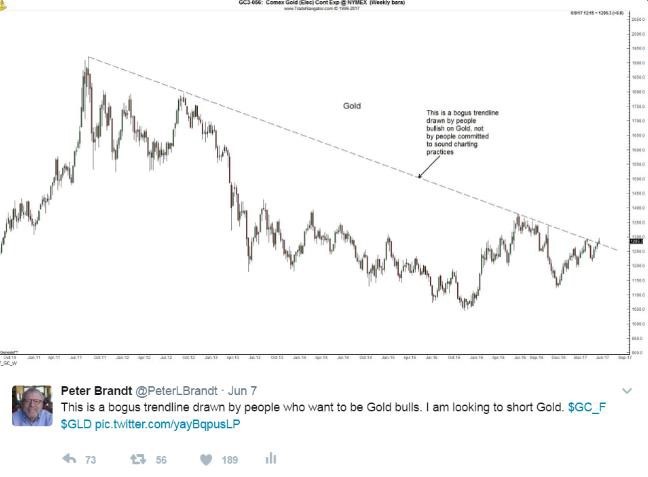This past week, I posted a Tweet stating an opinion that a Gold Trendline chart featured on financial social media by a number of “Gold bulls” was bogus. The issue is an apparent Gold Trendline connecting the Sep 2011, Oct 2012, Jul 2016, Aug 2016 and Apr 2017 highs. I received numerous inquiries on why I did not accept the trendline interpretation – and a number of critical comments.

Importantly, it was the validity of the present trendline I was challenging, not the analytical or trading abilities of others who believe that the Jun 6 penetration of the trendline represents a significant technical development. In fact, I have enormous respect for at least two other public voices (@jessefelder and @raoulpal) who point to this penetrated trendline as supportive of a bullish view of Gold. I do not hold my own opinion on chart developments to be superior to other very qualified market speculators.
I want to present two perspectives of the “Trendline” as a classical chart configuration – the first perspective through the lens of Robert Edwards and John Magee (“Technical Analysis of Stock Trends”) and the second perspective through my experience trading chart patterns for nearly 40 years.
First Perspective– Edwards and Magee on [Valid] Trendlines
Edwards’ and Magee’s narrative is in italics, followed by my comments.
“It is our purpose … to examine trends … to see how they [trendlines] can be used to reinforce or supplement the technical forecasts derived from our other chart formation[s]….”
Are there other recognizable chart configurations at play in Gold at the present time? Answer – NO!
On the Validity of Penetration –
“We can set up three tests or criteria … for determining decisive breakouts [from trendlines].”
The first is the extent of penetration. To be decisive, prices must not only push through the line but close beyond it by a margin equal to about 3% of the stock’s [or commodity’s] price.”













Leave A Comment